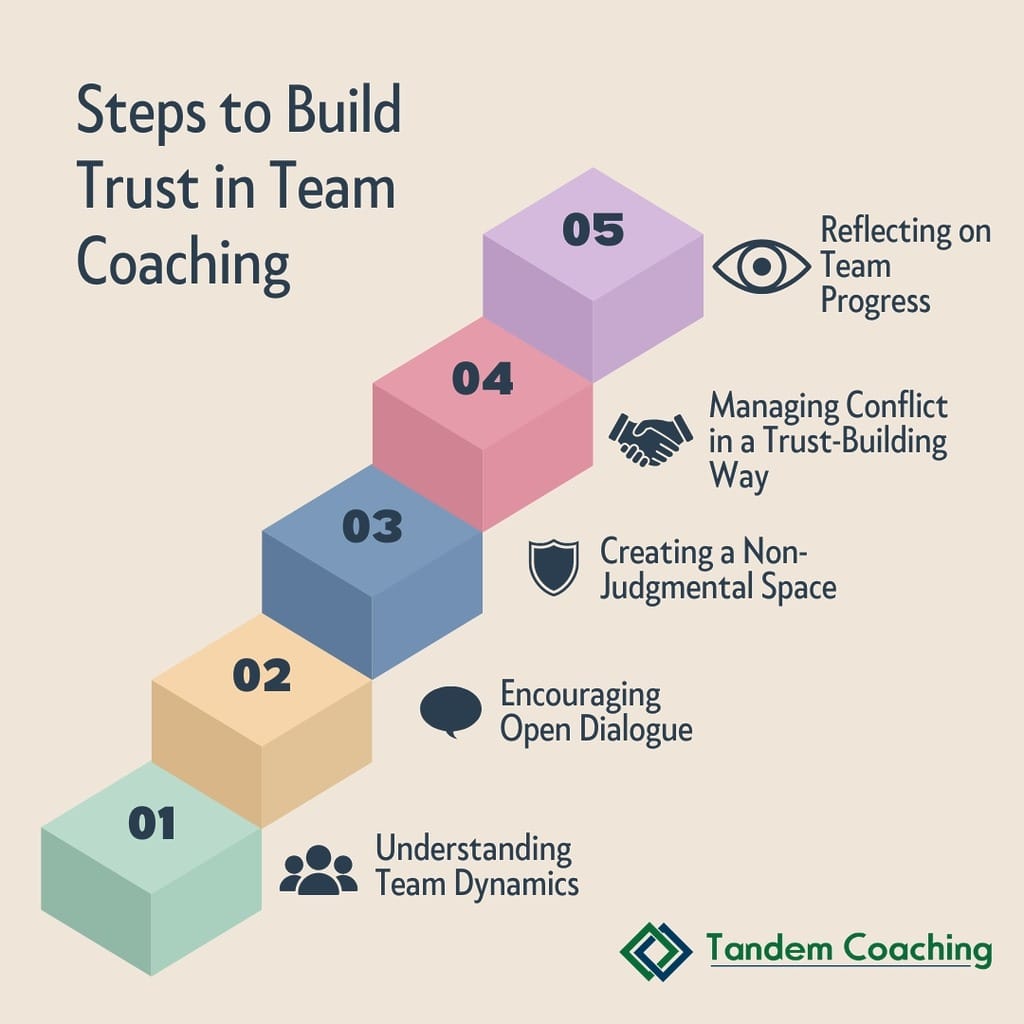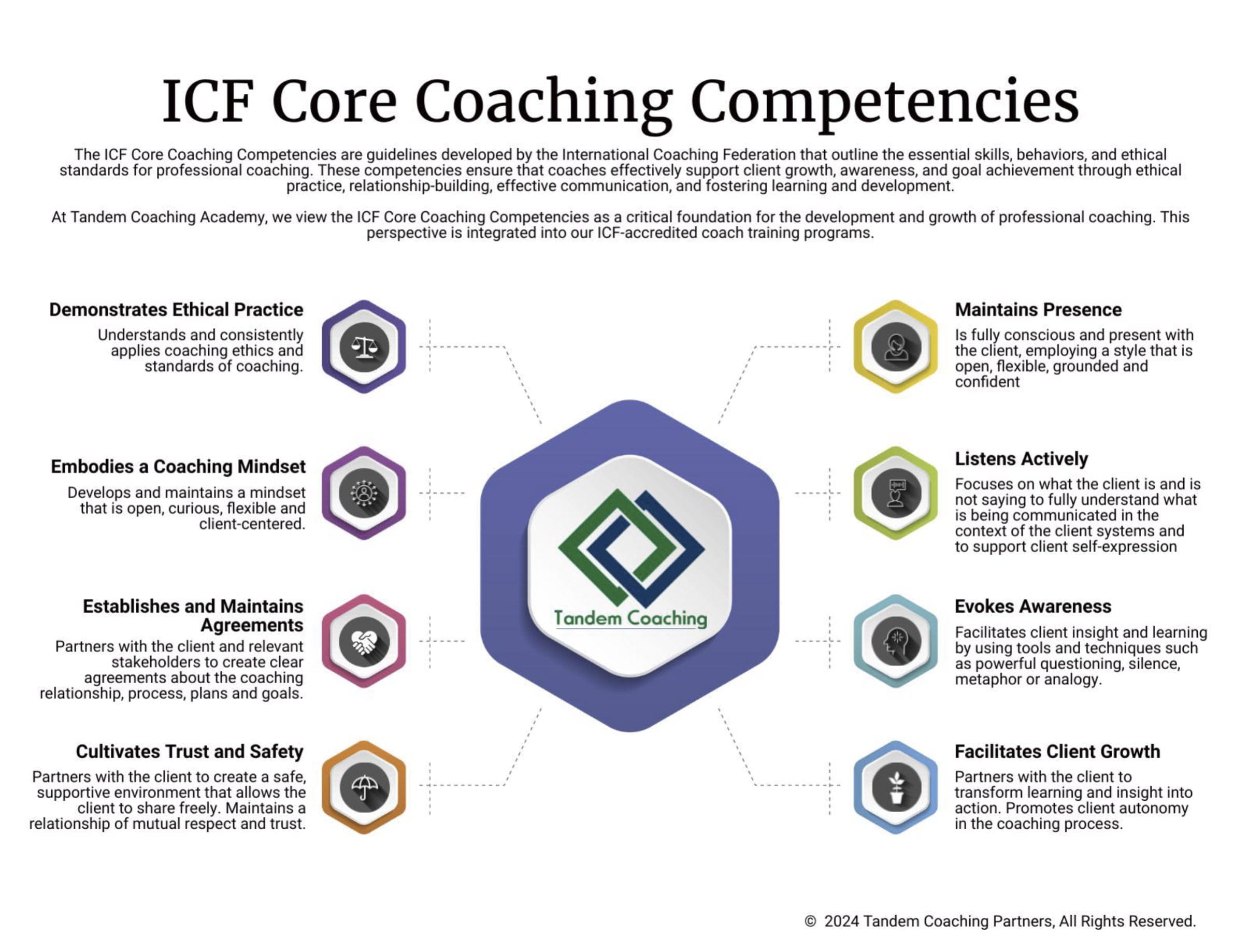Cultivating trust and safety is one of the most crucial competencies in team coaching. Without trust, teams struggle to collaborate effectively, share openly, and reach their full potential. As team coaches, creating a safe, supportive environment where every member feels heard, respected, and empowered to contribute is essential for team success.
In this article, we’ll explore how ICF’s Team Coaching Competency of “Cultivating Trust and Safety” forms the foundation of successful team coaching engagements. Whether you’re a seasoned coach or just starting, understanding how to foster trust within a group setting is critical to navigating team dynamics, resolving conflicts, and helping teams excel. We’ll dive into practical strategies for building trust, such as encouraging open dialogue, demonstrating vulnerability as a coach, and addressing team insecurities.
We’ll also differentiate between individual and team coaching contexts, highlighting how cultivating trust is more complex in a group environment where power dynamics, diverse backgrounds, and differing communication styles come into play. Throughout the article, we’ll provide real-world examples and techniques aligned with the ICF’s team coaching framework, ensuring you have the tools to create a psychologically safe space for your clients. Finally, we’ll discuss how mastering this competency enhances both team performance and your effectiveness as a coach.
Let’s dive into how to master the art of cultivating trust and safety and elevate your team coaching practice.
Trust in Action: Key Takeaways
- Trust is the Foundation: Building trust and psychological safety is essential for teams to thrive and collaborate effectively in a coaching environment.
- Open Dialogue is Critical: Encouraging open communication and ensuring every team member’s voice is heard are key to fostering trust and respect.
- Coach Vulnerability Matters: Demonstrating vulnerability as a coach can model transparency and help establish a deeper connection with the team.
- Team Dynamics Add Complexity: Cultivating trust in teams involves navigating diverse communication styles, power dynamics, and differing backgrounds, making it more complex than individual coaching.
- Practical Techniques: Use empathy, active listening, and reflective exercises to strengthen trust and create a safe, supportive environment.
- Conflict Management Builds Trust: Addressing and resolving conflicts within the team in a respectful, constructive manner further reinforces trust and psychological safety.
- Mastering Trust Benefits Teams: When trust is present, teams are more likely to perform better, innovate, and maintain long-term cohesion.
Why Trust and Safety Are Crucial in Team Coaching
Trust and safety are the bedrock of successful team coaching. Without these elements, even the most skilled coach will struggle to help a team achieve its full potential. In a team setting, where multiple personalities, backgrounds, and perspectives collide, fostering an environment where every member feels safe is essential. When teams feel secure, they are more willing to share ideas, challenge each other respectfully, and navigate difficult conversations.
In fact, studies have shown that teams with high levels of trust and psychological safety are more likely to innovate and solve problems effectively. This is because individuals are not afraid to take risks, offer creative solutions, or make mistakes. As a coach, your role is to cultivate this atmosphere, enabling team members to feel comfortable being vulnerable with each other.
For instance, imagine working with a nonprofit leadership team that has just gone through significant organizational changes. There’s tension, uncertainty, and hesitation to share thoughts openly. By focusing on creating psychological safety through open dialogue and empathy, you can help this team rebuild trust, allowing them to move forward with renewed confidence and collaboration.
“Trust is built in small moments, but it is the foundation of everything we do. Without it, teams struggle to connect and innovate.”
By emphasizing trust and safety, you empower teams to engage more fully in the coaching process, leading to stronger relationships and better outcomes.

Discover ICF PCC and ICF ACTC Team Coaching Competencies and Mastery
Are you eager to magnify the impact of your coaching practice?
Our ICF Team Competencies program offers a seamless transition for those who have mastered the core competencies, allowing you to delve deeper into the complexities and rewards of team coaching.
Explore this opportunity today.
The Core Practices of Cultivating Trust and Safety in Team Coaching
At the heart of cultivating trust and safety in team coaching are several core practices that coaches can use to create an environment where team members feel safe to speak up, share ideas, and take risks. These practices are key to breaking down barriers that may exist within the team, such as fear of judgment or hesitation to be vulnerable.
Understanding Team Dynamics and Individual Identities
Each team is a complex mix of personalities, backgrounds, and perspectives. A critical practice in cultivating trust is to understand the unique dynamics that exist within the team. This includes acknowledging the diversity of identities, experiences, and values that each member brings to the table. Coaches who can recognize and respect these differences will foster an environment where team members feel seen and understood.
For example, working with a team from a global nonprofit like Community Reach, you may encounter a variety of cultural perspectives. As a coach, adapting your approach to fit the diverse communication styles within the team will go a long way in building trust. The ability to navigate these dynamics effectively is what distinguishes a good team coach from a great one.
Encouraging Open Dialogue and Self-Expression
Creating a space where open dialogue is not only encouraged but expected is a powerful way to cultivate trust. Team members should feel comfortable expressing their ideas and concerns without fear of retribution. As a coach, facilitating this kind of open environment requires active listening and non-judgmental feedback.
Consider posing reflective questions to the team, such as, “How do we make this space safe for everyone to contribute openly?” Encouraging self-expression will empower quieter members to share their ideas, strengthening the team as a whole.
Creating a Non-Judgmental Space for Sharing
To truly foster trust, a non-judgmental space is essential. This means creating a coaching environment where team members know that their contributions won’t be criticized or dismissed. As a coach, demonstrating empathy and validating each person’s input, no matter how small, can encourage others to do the same.
For instance, in team settings like Empower Healthcare Network, where decisions affect both patient outcomes and internal staff morale, non-judgmental discussions are critical for navigating high-stakes conversations. Team members must feel comfortable bringing their concerns to the table without the fear of rejection.
“Psychological safety allows teams to share ideas freely and be open to critique without fear of embarrassment or punishment.”
Supporting open dialogue is vital, and more can be explored in articles like ICF Core Competencies: Understand, Respect, and Acknowledge.
Showing Empathy and Support
Empathy is a powerful tool in cultivating trust. When a coach shows genuine empathy, it builds a deeper connection with the team. This requires more than just listening—it involves understanding and appreciating the perspectives of team members, even when they differ from your own.
In teams where members may feel undervalued or overlooked, demonstrating empathy can make a significant difference. For instance, if a team member is struggling to contribute due to personal or professional challenges, acknowledging this and offering support can shift the dynamics of the entire team.
Practical Techniques for Cultivating Trust and Safety
Building trust within a team requires intentional effort and thoughtful techniques. While it may seem like a gradual process, there are practical steps coaches can take to establish a culture of trust and safety. These methods encourage openness and reduce barriers to effective collaboration.
Leveraging Vulnerability as a Trust-Building Tool
As a coach, demonstrating vulnerability can be one of the most powerful ways to foster trust within a team. By sharing your own experiences—whether related to previous coaching situations or personal challenges—you model the kind of openness you’re encouraging in the team. When team members see their coach being transparent, they’re more likely to feel comfortable doing the same.
For example, during a team coaching session, the coach might share a story about leading a team through uncertainty. This act of vulnerability could inspire team members to express their own concerns or challenges, leading to more honest and productive conversations.
“Vulnerability isn’t a weakness. It’s the key to unlocking deeper trust and fostering an environment where real growth can happen.”

Facilitating Transparent Conversations
Transparency is essential to creating trust, especially in teams where communication is often clouded by misunderstandings or unspoken concerns. One of the most effective ways to ensure transparency is by implementing structured feedback sessions, where each team member has the opportunity to share their thoughts openly.
In such sessions, the coach can ask targeted questions like, “What do you need from the team to feel more supported?” or “How can we communicate more effectively moving forward?” These questions not only promote transparency but also encourage team members to reflect on their own role in the trust-building process.
By fostering open, honest communication, you help teams navigate complex dynamics and create a clearer path toward their collective goals.
Using Reflection to Strengthen Team Trust
Reflection exercises are a valuable tool for reinforcing trust and ensuring the team continues to grow together. By pausing to reflect on their experiences, teams can identify areas where trust has been strengthened and where it still needs work. As a coach, incorporating reflective practices, such as post-session debriefs, allows teams to process what went well and what could be improved.
A reflective exercise might involve asking the team to individually identify one moment where they felt supported and one moment where they didn’t. These insights can then be discussed as a group, leading to deeper understanding and collaboration.
Reflective practices help keep trust-building an ongoing process, rather than a one-time achievement. More techniques like these can be found in 7 Cornerstones of Effective Team Coaching.
Managing Conflict in a Trust-Building Manner
Conflict is inevitable in any team, but how it’s managed can either strengthen or erode trust. As a coach, it’s critical to approach conflict as an opportunity for growth. Encouraging the team to address issues openly, rather than letting them fester, creates a stronger bond between members.
For instance, a coach might guide the team through a conflict resolution framework that focuses on clear communication, active listening, and empathetic responses. By reframing conflict as a positive force, coaches can help teams use these moments to reinforce trust rather than damage it.
“Conflict, when managed effectively, becomes a tool for strengthening the bonds of trust and collaboration within teams.”
The Impact of Trust and Safety on Team Performance
Trust and safety aren’t just feel-good elements; they have a direct impact on team performance. Teams that operate in environments of psychological safety are more innovative, collaborative, and resilient. When team members feel safe, they are willing to take risks, share unconventional ideas, and challenge each other in constructive ways.
Increased Collaboration and Innovation
One of the most significant benefits of cultivating trust within teams is the increase in collaboration. When team members trust each other, they are more likely to work together towards common goals. This level of collaboration is a key driver of innovation. Teams that feel safe are more willing to step outside of their comfort zones, experiment with new ideas, and challenge the status quo.
Research has shown that psychological safety is directly linked to team innovation. In a study published by Harvard Business School, it was found that teams with higher levels of psychological safety produced more innovative solutions because members were more open to taking risks and sharing ideas.
As a coach, encouraging a culture of trust can help unlock a team’s potential, enabling them to solve problems creatively and more efficiently. By fostering open communication, you create a space where even the most unconventional ideas are welcomed, leading to breakthroughs in performance.
Building Resilience Through Trust
Trust also plays a vital role in building team resilience. Teams that trust each other are better equipped to handle challenges and setbacks. When problems arise, trusted teams are more likely to approach them with a solution-focused mindset rather than engaging in blame or finger-pointing. This resilience allows teams to recover more quickly from obstacles and maintain high performance over time.
For example, in situations where a project hits unexpected roadblocks, teams with strong trust are more likely to collaborate on finding solutions rather than letting frustration fester. Coaches can facilitate this by promoting open dialogue and encouraging team members to approach problems with empathy and understanding.
“Resilient teams are built on trust. When trust exists, teams face challenges head-on and emerge stronger from setbacks.”
Strengthened Team Accountability and Commitment
Another critical impact of trust is the strengthening of team accountability. In a safe and trusting environment, team members feel more responsible for their contributions and are more committed to achieving collective goals. They are less likely to avoid responsibility or pass blame onto others, and more likely to own their part in both successes and failures.
A trusting environment also leads to stronger peer-to-peer accountability. Team members hold each other accountable not out of obligation but because they genuinely care about the team’s success. This level of commitment leads to higher-quality work and more consistent performance.
For coaches, emphasizing trust-building exercises and techniques can enhance team accountability and drive long-term success. Techniques for fostering this kind of team culture can be explored further in ICF Team Coaching Competencies for Team Coaches.

Discover ICF PCC and ICF ACTC Team Coaching Competencies and Mastery
Are you eager to magnify the impact of your coaching practice?
Our ICF Team Competencies program offers a seamless transition for those who have mastered the core competencies, allowing you to delve deeper into the complexities and rewards of team coaching.
Explore this opportunity today.
Challenges to Cultivating Trust in Diverse Teams
Cultivating trust in diverse teams can be particularly challenging due to the variety of backgrounds, communication styles, and perspectives each member brings to the table. While diversity strengthens a team by offering fresh ideas and unique approaches, it can also create barriers to trust if not managed effectively.
Navigating Power Dynamics in Teams
Power dynamics are a common issue in diverse teams, where differences in authority, expertise, or influence can make it harder for some members to feel comfortable sharing their ideas. Junior team members or those who are new may hesitate to contribute, especially if they feel overshadowed by more experienced colleagues.
As a coach, recognizing these dynamics and addressing them is crucial. A key technique is to create clear communication norms, ensuring every team member has equal opportunities to speak. For example, incorporating structured feedback sessions where quieter members are invited to share their thoughts can help mitigate power imbalances. These efforts help foster an environment where contributions are valued equally, regardless of seniority.
Overcoming Cultural and Communication Barriers
Cultural diversity, while an asset to teams, can also create challenges when it comes to communication. Different cultures often bring distinct communication styles, values, and expectations. For example, in some cultures, direct communication is encouraged, while in others, indirect or reserved communication is preferred. These differences can lead to misunderstandings if not properly navigated.
As a coach, you need to be flexible and culturally aware. Understanding and respecting these differences is critical to creating an inclusive environment where everyone feels heard. Encouraging discussions around communication preferences can be helpful in breaking down cultural barriers. For example, asking team members to share how they prefer to communicate allows everyone to adapt and find common ground.
“In diverse teams, cultural sensitivity is essential. By creating space for open conversations about communication styles, you ensure no one’s voice is lost.”
Addressing Resistance to Vulnerability
In diverse teams, some members may be resistant to vulnerability, especially if they come from backgrounds where openness is not typically encouraged. These team members might hesitate to share personal thoughts or concerns, fearing they will be judged or misunderstood.
One effective way to address this resistance is for the coach to model vulnerability in a way that keeps the focus on the team. For example, the coach could say, “I’m not entirely sure how this dynamic will play out, but I believe if we openly discuss it, we can find a solution together. What do you think?” This kind of statement demonstrates that it’s okay to be unsure, while still focusing on team collaboration rather than the coach’s own experience.
Additionally, admitting uncertainty during the process is another way to show that it’s safe to be vulnerable. A coach might say, “I’d like to try a new method, but I’m not sure how it will resonate. Your feedback will help us figure out if it works.” This frames vulnerability as part of the team’s journey and encourages members to share their own uncertainties.
By addressing these barriers head-on, coaches can create an environment that fosters trust and collaboration, even in diverse and complex teams.
Differences Between Team and Individual Coaching in Cultivating Trust
While cultivating trust is essential in both individual and team coaching, the dynamics involved are significantly different. In individual coaching, the relationship is one-on-one, allowing the coach to focus solely on building trust with a single person. In team coaching, however, the coach must foster trust among multiple individuals, each with unique personalities, backgrounds, and goals. This creates a more complex environment where trust needs to be cultivated not just between the coach and team members, but also among the team members themselves.

Unique Challenges in Team Trust-Building
In team coaching, the presence of group dynamics makes trust-building more complicated. Teams often include individuals with varying levels of trust in each other, and as a coach, you must help bridge those gaps. For instance, past conflicts, unbalanced power dynamics, or differing communication styles can all hinder the creation of a trusting environment.
To address these challenges, team coaches need to focus on group cohesion. One effective method is facilitating open dialogues where all members have an opportunity to voice concerns and expectations. This encourages transparency and creates a foundation for mutual trust. For example, using structured group sessions to surface unresolved conflicts or miscommunications can foster deeper understanding and respect among team members.
Another significant difference lies in the collective nature of team trust. In individual coaching, trust is a two-way street between the coach and client. However, in team coaching, it extends into a web of relationships among team members. The coach must encourage a culture of openness, where trust is shared across the team, not just between individuals and the coach.
“In team coaching, trust isn’t just a relationship between the coach and client—it’s a shared resource that connects everyone in the group.”
Similarities in Building Trust Across Contexts
Despite the added complexities of team coaching, some fundamental aspects of trust-building remain consistent across both contexts. For instance, both team and individual coaching require empathy, active listening, and genuine support. Coaches in both scenarios must create an environment where individuals feel valued, heard, and respected.
In both cases, vulnerability plays a key role. Whether working with one client or a team, showing vulnerability—such as admitting when the path forward is unclear—can help create psychological safety. Similarly, offering honest feedback and fostering transparent communication are trust-building techniques applicable in both settings.
However, in team coaching, the focus shifts slightly from individual reflection to collective reflection. Coaches must balance the needs of the group with the individual needs of each team member. This requires an awareness of how individual behaviors contribute to the team dynamic as a whole, making it critical to address interpersonal challenges that might arise.
For coaches seeking to deepen their understanding of how to build trust in group settings, the ICF Team Coaching Competencies provides valuable guidance on fostering trust and collaboration among diverse teams.
How to Assess Trust and Safety Within a Team
Assessing trust and safety in a team environment is crucial for ensuring that the coaching process is effective and that the team is on track to achieve its goals. Unlike individual coaching, where trust is easier to gauge through one-on-one interactions, team coaching requires a more nuanced approach. Coaches need to assess both the overall group dynamics and the individual contributions of each team member.

Indicators of a Trustful Team Environment
One of the most apparent indicators of trust within a team is open communication. In teams where trust is strong, members feel comfortable sharing their thoughts, asking questions, and providing feedback without fear of judgment or retribution. Conversely, in teams with low trust, members may hesitate to speak up, avoid difficult conversations, or rely on surface-level discussions that don’t address underlying issues.
A healthy sign of trust is when team members engage in constructive disagreements. When people trust each other, they are willing to challenge ideas and offer alternative perspectives, knowing that their input will be respected. In teams with high trust, these disagreements are handled respectfully and lead to deeper insights or solutions, rather than personal conflict.
Another key indicator of trust is the level of collaboration and mutual support among team members. Teams with strong trust often exhibit high levels of peer-to-peer accountability and actively help each other succeed. In such environments, it’s common to see members stepping in to assist without being prompted, or offering feedback to improve collective performance.
Tracking Progress: Regular Team Check-Ins
To assess and maintain trust within a team, regular check-ins are essential. Coaches can schedule dedicated reflection moments during which team members are encouraged to discuss how safe and supported they feel. These sessions might include specific questions like, “Do you feel comfortable sharing your ideas with the group?” or “What can we do to create a more open and supportive environment?”
Another method is to use anonymous surveys, which allow team members to provide honest feedback without the pressure of speaking in front of the group. These surveys can include questions that measure how psychologically safe each member feels and whether they trust their peers and the coaching process.
“Trust isn’t static—it needs to be nurtured and reassessed regularly to ensure it remains strong as the team evolves.”
Reflecting on recent team interactions can also provide clues. For example, has the team’s willingness to engage in difficult conversations increased? Are they more likely to offer help to one another without being asked? Coaches should look for these behavioral shifts as markers of growing trust.
Coaches can also benefit from using tools such as team coaching assessments or group reflection exercises to monitor trust and collaboration. For more insights on assessing and developing trust in teams, the 7 Cornerstones of Effective Team Coaching offers practical guidance.
Achieving Mastery in Cultivating Trust and Safety
Cultivating trust and safety is not a one-time achievement but a continuous process that requires ongoing attention and skill development. For coaches, mastering this competency is crucial to becoming a trusted partner to the teams they work with. By refining your techniques, deepening your understanding of team dynamics, and engaging in self-reflection, you can create lasting change in the teams you coach.
Continuous Reflection and Learning as a Coach
One of the most important aspects of mastering trust-building is self-reflection. Coaches need to regularly assess their own behavior and coaching methods to ensure they are contributing positively to the team’s trust dynamics. This might involve reflecting on questions such as: Am I creating an open and safe space for all team members? How can I better adapt to the unique needs of this team?
Ongoing learning is another critical component. The field of team coaching is constantly evolving, and staying informed about new techniques and insights can help coaches improve their practice. Attending workshops, engaging in peer supervision, or seeking feedback from fellow coaches are all valuable ways to deepen your expertise in cultivating trust. The ICF Team Coaching Competencies provide a framework for assessing your progress and ensuring you are aligned with best practices in team coaching.
Leveraging Peer Feedback and Supervision
One powerful way to refine your approach to building trust is through peer feedback and supervision. Working with other coaches to review challenging situations can provide new perspectives on how to navigate complex team dynamics. For example, discussing a situation where team members were reluctant to open up may lead to discovering new strategies for fostering psychological safety.
Supervision sessions are also invaluable for coaches looking to develop deeper insights into their coaching methods. During supervision, a senior coach can provide constructive feedback, helping you identify blind spots and areas where you can enhance your effectiveness in trust-building.
“Mastering the art of cultivating trust requires humility, self-awareness, and a commitment to learning from both successes and challenges.”
Assessing Progress: Signs of Trust in Teams
Mastering the cultivation of trust also involves knowing how to recognize when your efforts are working. Some clear signs of success include increased openness during team discussions, a willingness to engage in constructive conflict, and a sense of mutual support among team members. Coaches who have mastered this competency can often see their influence reflected in how team members hold each other accountable, communicate transparently, and collaborate more effectively.
Coaches who prioritize these ongoing learning practices and regularly reflect on their coaching approaches will find that their teams are not only more cohesive but also more resilient and capable of handling challenges as they arise. Mastering trust-building takes time, but the rewards are well worth the effort.
Conclusion
Cultivating trust and safety within teams is one of the most critical competencies a coach can master. It’s the foundation that allows teams to communicate openly, navigate conflicts, and collaborate effectively toward their goals. As we’ve explored, trust-building in team coaching requires intentional practices, such as encouraging open dialogue, managing power dynamics, respecting cultural differences, and demonstrating vulnerability. When coaches focus on these aspects, they create an environment where every team member feels valued and supported.
Mastering this competency doesn’t happen overnight—it’s an ongoing process that involves self-reflection, continuous learning, and leveraging feedback from peers. By investing time and effort into cultivating trust, you can not only improve the dynamics within teams but also enhance your effectiveness as a coach.
If you’re looking to deepen your skills in cultivating trust and safety, consider pursuing advanced team coaching certifications, such as the ICF’s Advanced Certification in Team Coaching (ACTC). This program is designed to help coaches refine their techniques and become more effective at guiding teams through complex challenges.
Explore more about how to master team coaching competencies and elevate your coaching practice with Tandem Coaching ACTC Program. Start building trust within your teams today and watch how it transforms their performance and cohesion.
Frequently Asked Questions about Cultivating Trust and Safety for Teams
Why is cultivating trust and safety important in team coaching?
Trust and safety are essential in team coaching because they create the foundation for open communication, collaboration, and innovation. Without trust, team members may hesitate to share ideas or express concerns, hindering the team’s progress. A safe environment allows for honest feedback, constructive conflict, and stronger relationships. This competency helps teams operate at their full potential, enhancing their overall performance.
How does team coaching differ from individual coaching in terms of trust-building?
In individual coaching, trust is built directly between the coach and the client. In team coaching, however, the dynamic is more complex, as trust must be cultivated not only between the coach and each team member but also among the team members themselves. This adds layers of complexity, as the coach needs to manage group dynamics and encourage peer-to-peer trust.
What are practical steps for building trust within a team?
Building trust in a team requires a multi-step approach, including:
- Encouraging open communication by fostering a non-judgmental space.
- Modeling vulnerability as a coach to show it’s okay to express uncertainties.
- Using structured feedback sessions to give every team member a voice.
- Managing conflict constructively to ensure disagreements lead to growth, not division.
How can I assess the level of trust within a team?
To assess trust within a team, look for key indicators such as:
- Open and honest communication.
- Team members’ willingness to engage in constructive conflict.
- Peer collaboration and support. Regular check-ins, reflection sessions, and anonymous feedback surveys can provide additional insights into the team’s trust levels. A more detailed approach to assessing trust is discussed in the section How to Assess Trust and Safety Within a Team in this article.
What role does cultural diversity play in cultivating trust in a team?
Cultural diversity can enhance a team’s creativity and innovation but can also create barriers to trust if not managed carefully. Different cultural backgrounds often bring varying communication styles and expectations, which can lead to misunderstandings. Coaches need to be culturally sensitive, encouraging discussions about communication preferences and ensuring everyone feels heard. For more on overcoming cultural barriers, you can explore Understanding and Respecting Cultural Differences in Team Coaching.
What is the difference between psychological safety and trust?
While both psychological safety and trust are crucial for team success, they are distinct concepts. Psychological safety refers to a team member’s perception that they can take interpersonal risks—such as asking questions, offering feedback, or admitting mistakes—without fear of punishment or ridicule. Trust, on the other hand, involves the belief that others in the team will act in your best interests. Together, they create an environment where team members can openly communicate and collaborate.
How can a coach model vulnerability to build trust in a team?
A coach can model vulnerability by openly admitting when they are unsure about an approach or by encouraging feedback on their coaching methods. For instance, a coach might say, “I’m not sure if this method will work for everyone, but I’d like us to try it and gather feedback to see how we can adjust it.” This demonstrates that it’s safe for team members to express their own uncertainties, encouraging a culture of openness.
How do you manage power dynamics within a team to build trust?
Power dynamics can hinder trust if some team members feel overshadowed or hesitant to contribute. As a coach, you can create structured communication opportunities that give every team member, regardless of rank or experience, a chance to speak. Encouraging equal participation and fostering peer accountability helps balance these dynamics and promotes trust across the entire team.
What are the signs that a team lacks trust?
A lack of trust in a team can manifest in several ways, including:
- Hesitation to share ideas or feedback.
- Superficial discussions that avoid deeper issues.
- Blame-shifting or lack of accountability.
- A reluctance to engage in constructive conflict. If you notice these signs, it’s important to address them early by facilitating open dialogue and creating a safe space for honest conversations.
How can I as a coach facilitate transparency in team coaching?
Facilitating transparency in team coaching involves promoting open and honest communication. You can achieve this by creating feedback loops, where each team member feels comfortable expressing their thoughts. For example, you can ask, “What can we do to make our conversations more open and transparent?” This encourages team members to contribute ideas on how to enhance communication and trust.

Unlock Your Coaching Potential with Tandem!
Dive into the essence of effective coaching with our exclusive brochure, meticulously crafted to help you master the ICF Core Coaching Competencies.
"*" indicates required fields
About the Author
Cherie Silas, MCC
She has over 20 years of experience as a corporate leader and uses that background to partner with business executives and their leadership teams to identify and solve their most challenging people, process, and business problems in measurable ways.












